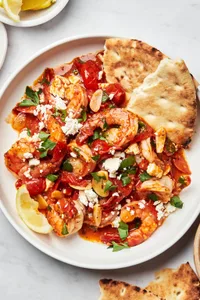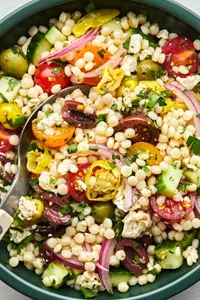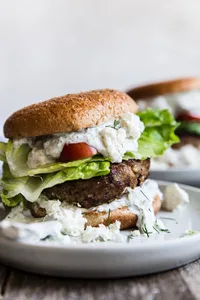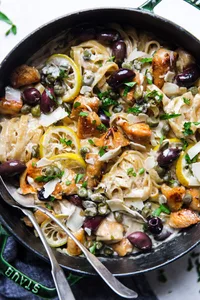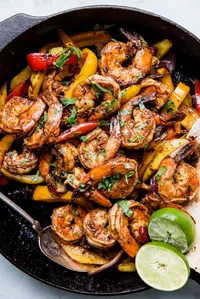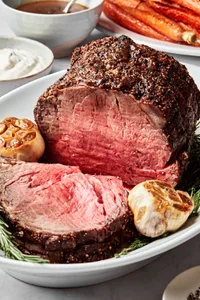Greek Shrimp: The Best Kind of One-Pan Mediterranean Meal
This classic Greek dish is bursting with fresh flavor and delivers all of the best parts of the Mediterranean in a one-pan preparation. It’s healthy, easy and satisfying. You’ll sometimes see it called “Shrimp Santornini” or “garides saganaki” which refers to the type of dish (a sagani) the shrimp (garides) are cooked in. It’s the perfect marriage of simple and deeply flavorful, and Greek shrimp pairs well with just about anything. For more easy shrimp recipes, check out our grilled shrimp or classic Shrimp Scampi.
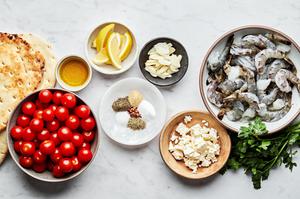
Everything You’ll Need to Make Greek Shrimp with Tomatoes and Feta
The ingredients list for this Greek shrimp recipe reads like a Mediterranean diet 101 primer. Olive oil, seafood, herbs and spices—it’s all good and good for you. Use the ripest cherry tomatoes you can find! A recipe as simple as this will only be as good as the quality of your ingredients and the quality of the shrimp and tomatoes especially matter here.
Extra-virgin olive oil
Large shrimp
Cherry tomatoes
Feta cheese
Fresh garlic
Oregano
Thyme
Garlic powder
Sugar
Red pepper flakes
Parsley
Lemons
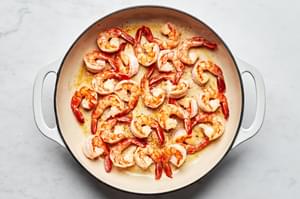
How To Make Our Easy Greek Shrimp Recipe
Easy, quick, healthy, yummy—Greek shrimp really is everything we love dinner to be. You can serve it to company alongside some fluffy white rice and lovely white wine for a speedy, low-stress supper that still feels special and indulgent. Or, it makes a really nice weeknight meal when you just need something that you know everyone will love and that comes together quickly (total time in the kitchen is just over a half hour!). Here’s how to make it:
Sauté the shrimp in olive oil until it’s cooked through and set aside. How long does it take to cook shrimp in a pan? Shrimp cooks pretty quickly, about 3-4 minutes in the hot oil will do it.
Cook the cherry tomatoes in the same skillet in more olive oil for about five minutes, until they begin to blister.
Add the fresh garlic and, a few minutes later, the oregano, thyme, garlic powder, sugar, salt and crushed red pepper flakes. Simmer and stir until it all becomes cohesive and fragrant—just a couple of minutes.
Add the shrimp back to the pan, toss to coat and finish the whole dish with those crumbles of feta cheese and a squeeze of fresh lemon juice.
Serve! And if you’re looking to be uber traditional, you’ll cheers everyone at the table with a glass of ouzo!
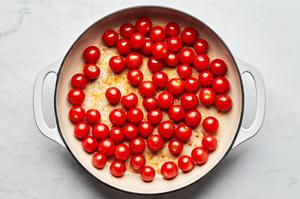
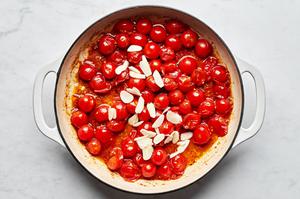
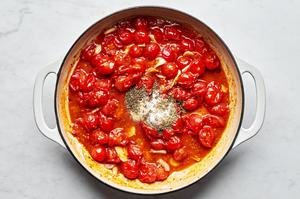
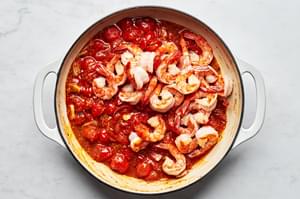
Everything You Need to Know About Buying Shrimp
Shrimp size: Here in the U.S., shrimp is sold by weight. When shrimp size is referenced—”jumbo”, “medium” “small” and so on—that size correlates with the number of shrimp per pound. For this recipe, we’re calling for large shrimp, which means we’d expect you to get roughly 26 shrimp per pound.
How to buy the best shrimp: Buying wild, American shrimp is a good way to cut any worries about inhumane labor practices right out of the equation. Look for wild Gulf shrimp—fresh or frozen are both fine. If you’re buying frozen shrimp, always check the label for preservatives. The only ingredient should be “shrimp.”
Consider sustainability when you’re shopping for seafood and especially something super-popular like shrimp. There are a couple of organizations that certify seafood as sustainable, like the Marine Stewardship Council and the Aquaculture Stewardship Council, so you can look for labels that carry a seal from either of these organizations and if you see one, you can feel really good about your purchase! When in doubt, you can always cross-reference your shrimp buying options with the Monterey Bay Aquarium's excellent “Seafood Watch” site or app.
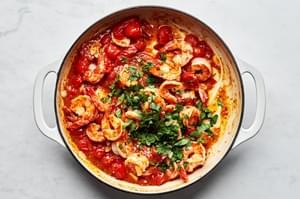
How to Clean Shrimp
While it's not technically necessary to devein your shrimp, the “vein” is the shrimp’s digestive tract, and it can have a little sand or grit in it sometimes, so we like to remove it. Here's how to prep shrimp:
Defrost! Defrost your shrimp (if they’re frozen) in a bowl of cold water in the fridge.
Peel! Begin to peel the shrimp by holding the shrimp in one hand and use your other hand to peel off the legs. Once the legs have been removed, you can take the shrimp shell off by peeling it, beginning from where you took off the legs.
To keep the tail on, just hold it firmly in place with one hand while you peel the shell of the body of the shrimp with your other hand.
To remove the vein, hold the shrimp with the back side up. Use a sharp, small knife (like a paring knife) to make a shallow cut along the vein (the dark line that runs along the back of the shrimp). Once you've made the incision, use the tip of the knife to scrape out the vein. And you’re done!
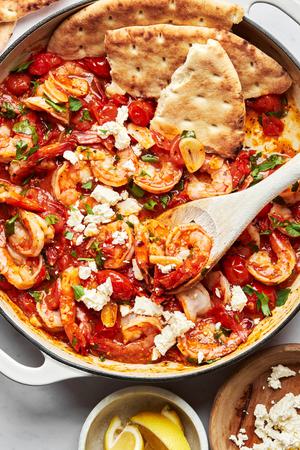
What To Serve with Greek Shrimp
The sky’s the limit! Greek shrimp stands alone, or goes with most anything. Here are a few serving ideas to get you going:
Atop White Bean Hummus with some good crusty bread (pictured here!)
Tossed with pasta (any kind!) to make a simple, yummy Greek shrimp pasta.
With a big Greek salad for a low-carb feast.
And if you’d like to make other shrimp recipes now that you’ve perfected the art of cleaning shrimp, there’s Shrimp Scampi, Shrimp Tacos or Shrimp Fajitas, Chimichurri Shrimp with Creamy Polenta, and Shrimp Louie.
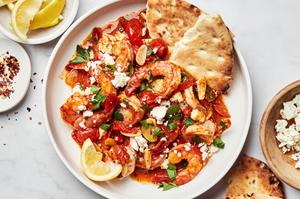
More Great Mediterranean Recipes to Try
We will gladly frolic through the Mediterranean region through the various delicious plates it has to offer. Here’s a few more great recipes:
One Pot Creamy Mediterranean Chicken Pasta for that full Kalamata olives and lemony goodness to add a kick to any dinner
Mediterranean Turkey Burger with feta and onions and an amazing tzatziki sauce
Mediterranean Couscous Salad with crunchy cucumber and briny olives
Did we mention we love meatballs? These Mediterranean Meatballs with Tzatziki deliver major flavor!
For the Love of Shrimp
We really do love shrimp, and this lovely Greek shrimp recipe is one of our faves. Especially because this simple meal is so easy and so fun to make (not to mention fun to eat). We hope you try it! When you make it, let us know how you like it! Share a photo and tag us on Instagram using @themodernproper and #themodernproper so that we can see your stuff! Happy eating!
